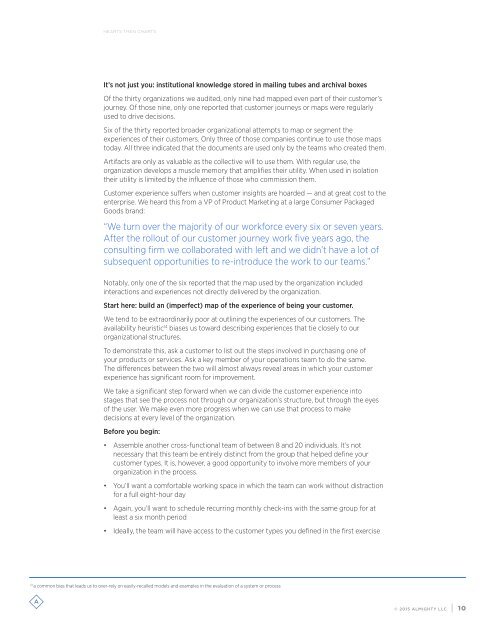Hearts then Charts
Almighty_HeartThenCharts_2015
Almighty_HeartThenCharts_2015
Create successful ePaper yourself
Turn your PDF publications into a flip-book with our unique Google optimized e-Paper software.
HEARTS THEN CHARTS<br />
It’s not just you: institutional knowledge stored in mailing tubes and archival boxes<br />
Of the thirty organizations we audited, only nine had mapped even part of their customer’s<br />
journey. Of those nine, only one reported that customer journeys or maps were regularly<br />
used to drive decisions.<br />
Six of the thirty reported broader organizational attempts to map or segment the<br />
experiences of their customers. Only three of those companies continue to use those maps<br />
today. All three indicated that the documents are used only by the teams who created them.<br />
Artifacts are only as valuable as the collective will to use them. With regular use, the<br />
organization develops a muscle memory that amplifies their utility. When used in isolation<br />
their utility is limited by the influence of those who commission them.<br />
Customer experience suffers when customer insights are hoarded — and at great cost to the<br />
enterprise. We heard this from a VP of Product Marketing at a large Consumer Packaged<br />
Goods brand:<br />
“We turn over the majority of our workforce every six or seven years.<br />
After the rollout of our customer journey work five years ago, the<br />
consulting firm we collaborated with left and we didn’t have a lot of<br />
subsequent opportunities to re-introduce the work to our teams.”<br />
Notably, only one of the six reported that the map used by the organization included<br />
interactions and experiences not directly delivered by the organization.<br />
Start here: build an (imperfect) map of the experience of being your customer.<br />
We tend to be extraordinarily poor at outlining the experiences of our customers. The<br />
availability heuristic 14 biases us toward describing experiences that tie closely to our<br />
organizational structures.<br />
To demonstrate this, ask a customer to list out the steps involved in purchasing one of<br />
your products or services. Ask a key member of your operations team to do the same.<br />
The differences between the two will almost always reveal areas in which your customer<br />
experience has significant room for improvement.<br />
We take a significant step forward when we can divide the customer experience into<br />
stages that see the process not through our organization’s structure, but through the eyes<br />
of the user. We make even more progress when we can use that process to make<br />
decisions at every level of the organization.<br />
Before you begin:<br />
• Assemble another cross-functional team of between 8 and 20 individuals. It’s not<br />
necessary that this team be entirely distinct from the group that helped define your<br />
customer types. It is, however, a good opportunity to involve more members of your<br />
organization in the process.<br />
• You’ll want a comfortable working space in which the team can work without distraction<br />
for a full eight-hour day<br />
• Again, you’ll want to schedule recurring monthly check-ins with the same group for at<br />
least a six month period<br />
• Ideally, the team will have access to the customer types you defined in the first exercise<br />
14<br />
a common bias that leads us to over-rely on easily-recalled models and examples in the evaluation of a system or process<br />
© 2015 ALMIGHTY LLC | 10


